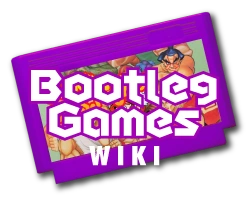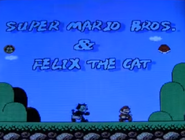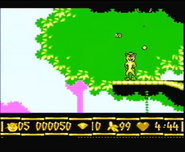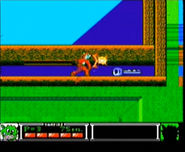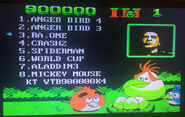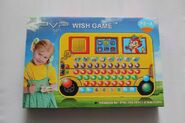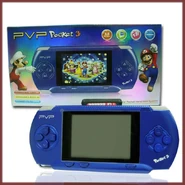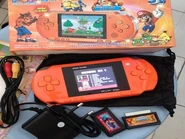(Added a new page, still needs more information.) |
No edit summary Tag: Visual edit |
||
| (44 intermediate revisions by 20 users not shown) | |||
| Line 1: | Line 1: | ||
| + | {{Infobox console |
||
| − | [[File:Placeholder|video|right|300px]] [[File:Placeholder|right|300px]] |
||
| + | | name = Play Vision Portable |
||
| − | The Play Vision Portable was a NES-On-a-Chip (NOAC) that looked liked like a PlayStaion Portable (PSP). |
||
| + | | image = File:PVP box.jpg |
||
| + | | caption = The original model's box. |
||
| + | | date = 2011-present |
||
| + | | manufacturer = Unknown, possibly Touch Game Player |
||
| + | | system = Famiclone/"Firecore" Mega Drive clone |
||
| + | }} |
||
| + | '''Play Vision Portable''', commonly abbreviated as the '''PVP''' or '''PVP Station''', is the name of a series of handheld consoles that resemble Sony's [[wikipedia:PlayStation Portable|PlayStation Portable]] system. Many models exist, which are based on either Famiclone or Mega Drive/Genesis hardware depending on the unit. It is possibly based on the Europe-exclusive PSP-E1000 revision. |
||
| − | ==Background== |
+ | == Background == |
| + | The first revision of the PVP was released around 2011. The console was an NES clone with built-in games, some of which were contained on a proprietary cartridge (which was designed to resemble a Game Boy Advance game). PVP carts only trigger a switch for their original console, similar to the [[N-Joypad]], and when they are placed in other revisions they will not run the intended menu; however, some models intentionally do not include a cartridge they are capable of running, so they can be rebranded as different units later. If a cartridge containing the necessary pins is put inside, another list can potentially run. It has a rechargeable battery and, depending on the unit, uses either a Game Boy Advance SP charger or a USB charger. |
||
| − | The PVP came around the 2011 (?), the console was an NES clone that has buit-in games. |
||
| + | Many different models of the PVP exist, and they are somewhat hard to distinguish from each other. Even systems that share the same name and box art can have a different game list, or potentially be based on an entirely different console platform. Quality can also vary between models, with several featuring problems such as incorrect screen sizes (leading to the graphics looking squashed) and charger malfunctions. |
||
| − | ==The PVP's Box== |
||
| − | The PVP's box claims that it has 100% full color, the box also claims to have 8,888 "hot" games. The box also says "Super Big Screen, Super More Joy, Super More Games!" |
||
| + | A later model, the ''PVP 2'', is a Mega Drive/Sega Genesis clone. They are based on [[Firecore]] architecture, a cheap and somewhat poor clone hardware popularized by [[AtGames]]. This hardware was reused in the ''[[PXP3|PVP 3]]'' (also known as the ''PXP3''). |
||
| ⚫ | |||
| + | |||
| + | A system called the ''PVP Crash 9'' is based on [[VT03]] hardware (although this is menu only, the included games are standard NES) and uses different cartridges. This variation is sometimes referred to as the PVP Station Light. |
||
| + | |||
| + | Another variation is known as simply the ''PVP Game''. This variation is in a differently shaped shell that somewhat resembles a Game Boy Advance. This console is the only version of the PVP to feature a truthful game list of 168 games, as all other models feature exaggerated menu items. |
||
| + | |||
| + | An educational device known as the ''PVP Wish Game'' features a completely different design - it is flat and resembles a schoolbus, and features a keyboard. Most of its contents are unknown, but it seems to feature mostly [[Nice Code Software|Nice Code games]]. |
||
| + | |||
| + | NES-based systems will often feature intro sequences, often based on media unrelated to the unit in question. These include ''Gangnam Style'', ''What Does the Fox Say'', ''Angry Birds'' and one combining both ''Super Mario Bros.'' and ''Felix the Cat''. Genesis-based units do not feature these, presumably to save space. The menus will often feature preview images for each game, although earlier units do not have this feature. |
||
| + | |||
| + | <gallery> |
||
| + | Slightlylessdumb.png|Example of an intro. |
||
| + | </gallery> |
||
| + | |||
| + | == List of Included Games == |
||
| + | Due to the many PVP models, not every title can be documented, but here's a list of some more common and/or interesting titles: |
||
| + | |||
| + | === '''Hacks''' === |
||
| + | *''Crash'' - hack of ''The Jungle Book'' that replaces Mowgli with a naked Crash Bandicoot. Most versions leave the Walt Disney copyrights intact (leading to the title screen humorously reading "Walt Disney's Crash"), although there are versions that replace this with "www.touchgameplayer.com". |
||
| + | |||
| + | <gallery> |
||
| + | Dumb1.png |
||
| + | </gallery> |
||
| + | |||
| + | *''Crash 2'' - hack of ''Monsters in my Pocket'' which changes the characters' sprites into red and blue Crashes. The copyrights read "Crash 2" and the title screen has been removed. |
||
| + | |||
| + | <gallery> |
||
| + | Dumb6.png |
||
| + | </gallery> |
||
| + | |||
| + | *''Crash 3'' - hack of ''Mitsume ga Tooru'' that swaps out Hosuke's head with Crash's. All other graphics, including the title screen, are intact. |
||
| + | |||
| + | *''Crash 4'' - hack of ''Little Nemo - The Dream Master'' that replaces Nemo's main sprites with Crash - however, all transformation and story graphics are intact. |
||
| + | |||
| + | <gallery> |
||
| + | Dumb3.png |
||
| + | </gallery> |
||
| + | |||
| + | *''Angry Birds'' - hack of ''Moai-kun'' that changes nearly all of the sprites to be Angry Birds themed. Some consoles alter the title screen to say "Anger Bird". |
||
| + | |||
| + | <gallery> |
||
| + | Dumb4.png |
||
| + | </gallery> |
||
| + | |||
| + | *''Angry Birds 2'' - hack of ''The New Zealand Story'' that replaces Tiki with a red Angry Bird and some of the enemies with helmet-wearing pigs. The title sometimes reads "Anger Birds" and is occasionally listed as the fourth installment. |
||
| + | |||
| + | <gallery> |
||
| + | Dumb5.png |
||
| + | </gallery> |
||
| + | |||
| + | *''Angry Birds 2 (2)'' - hack of ''Flipull'' featuring an Angry Bird. The bird's colors often revert back to the blob creature's, and the title screen says "An Exciting Cube Game". |
||
| + | |||
| + | <gallery> |
||
| + | angerensues.jpg |
||
| + | </gallery> |
||
| + | |||
| + | *''Shaun the Sheep'' - another ''Little Nemo'' hack starring Shaun the Sheep. The story graphics have been altered, but it is unknown if the power-ups have, due to the only system the game is known to be included on lacking a Select button. |
||
| + | |||
| + | <gallery> |
||
| + | Dumb2.png |
||
| + | </gallery> |
||
| + | |||
| + | *''Khresna'' - a hack of ''Donald Land'' based on the cartoon ''Little Krishna'', which changes Ronald McDonald's sprites. Like Crash 2, the title has been removed and the copyrights read "2010 Etta Khresna". |
||
| + | |||
| + | <gallery> |
||
| + | Dumb7.png |
||
| + | </gallery> |
||
| + | *''Ra.One'' - an extremely poor hack of ''Tokkyuu Shirei Solbrain'' based on a 2011 action film, that only alters one graphic, that being the cutscene graphic of the character before he is transformed. |
||
| + | |||
| + | <gallery> |
||
| + | cheapbastards.jpg |
||
| + | </gallery> |
||
| + | *''Pokoyo Pokoyo'' - a hack of ''Bubble Bobble Part 2'' seemingly based on the children's TV series ''Pocoyo''. |
||
| + | |||
| + | *''Dance Gangnam Style'' - a hack of Nice Code's ''[[Street Dance]]'' with Gangnam Style as the only music track. It was likely created by Nice Code themselves, but it has only ever appeared on PVP systems. |
||
| + | |||
| + | <gallery> |
||
| + | op.jpg |
||
| + | </gallery> |
||
| + | *''Peppa Pig'' - Another hack of ''Bubble Bobble Part 2'' that replaces the player's main sprites with Peppa Pig and Susie Sheep. |
||
| + | *''Shimmer Shine'' - a hack of ''Felix The Cat'' seemingly based on the TV series Shimmer & Shine, like Pocoyo. |
||
| + | *''Bernat - The Dream Master'' - Another ''Little Nemo'' hack featuring a character resembling Yogi Bear. |
||
| + | |||
| + | === '''NES''' === |
||
| + | *''Super Mario Bros.'' trilogy |
||
| + | *''Donkey Kong'' trilogy |
||
| + | *[[Mario Pirate Hacks|"Numbered" Mario Hacks]] ([[Super Bros. 6|6]], [[Super Bros. 9|9]], [[Super Bros. 10: Kung Fu Mario|10]], [[Super Mario 14|14]] and [[Mario 16|16]]) |
||
| + | *Adventure Island 1 and 2 |
||
| + | *[[Angry Birds (Famicom)|''Angry Birds'']] (usually listed as "Angry Bird 3" to go in line with their Angry Birds hacks numerically) |
||
| + | *[[Plants vs. Zombies]] |
||
| + | *''Contra'' |
||
| + | *Super Contra |
||
| + | *Contra Force (either that, or the [[Super Contra 6]] hack) |
||
| + | *[[Somari|''Sonic the Hedgehog'']] |
||
| + | *[[Magic Jewelry|''Magic Jewelry'']] |
||
| + | *''Karateka'' (sometimes listed as "Tekken", an incorrect name originating from the [[Power Player Super Joy III|Super Joy III]]) |
||
| + | *''Felix the Cat'' |
||
| + | *[[King of Fighters '97]] |
||
| + | *[[Street Fighter II Pro|Street Fighter VI:12 Peoples]] |
||
| + | *[[Tom & Jerry 3|''Tom & Jerry 3'']] |
||
| + | *[[Tetris: The Soviet Mind Game|Tetris (Tengen)]] |
||
| + | *A wide variety of [[Nice Code Software|Nice Code]] and/or [[Inventor]] games |
||
| + | *Soccer |
||
| + | |||
| + | === '''Mega Drive/Genesis''' === |
||
| + | *''Sonic The Hedgehog'' trilogy (typically limited to one game per system, which is most commonly Sonic 1) |
||
| + | *''Sonic Spinball'' |
||
| + | *Sonic 3D Blast |
||
| + | *''Sonic Eraser'' (prototype that was only originally released through Sega's ''Meganet'' service) |
||
| + | *''Super Mario Bros.'' ([[Squirrel King]] hack) |
||
| + | *[[Super Mario Bros. 2 (Mega Drive)|''Super Mario Bros. 2'']] (Sonic Jam 6 may also be included, but usually as a repeat and not standalone on a system) |
||
| + | *''Pac-Mania'' |
||
| + | *SNK Games (mainly Fatal Fury 2, Art of Fighting and/or Samurai Shodown) |
||
| + | *Streets of Rage trilogy (Most commonly Streets of Rage 3) |
||
| + | *Earthworm Jim 2 |
||
| + | *Contra Hard Corps |
||
| + | *[[Angry Birds (Sega Genesis)|Angry Birds]] |
||
| + | *Bubbles Master (Typically listed as "Zuma Bubbles", it seems to have been ported over from the ATgames plug and plays) |
||
| + | *Super Street Fighter 2 (at least in the more recent ones) |
||
| + | *Shinobi 3 |
||
| + | *Columns 3 |
||
| + | *''Alex Kidd in The Enchanted Castle'' |
||
| + | *''Tetris'' (prototype) |
||
| + | *''Sunset Riders'' |
||
| + | *[[Tekken Special]] (specifically the "Tekken Special 3" title hack) |
||
| + | *[[Crash Bandicoot|''Crash Bandicoot'']] |
||
| + | |||
| ⚫ | |||
| + | <gallery> |
||
| + | PVP_box.jpg|PVP box. This model is believed to be the first version. (NES-based) |
||
| + | PVP_2.jpg|PVP 2 box. (Genesis-based) |
||
| + | Waitwhat.jpg|PVP Wish Game box. (VT03-based) |
||
| + | 64.jpg|PVP Wish Game 64-Bit box. Its contents are unknown. |
||
| + | end.jpg|PVP Pocket 3. Its contents are unknown. The M on Mario's hat is a W for whatever reason. |
||
| + | nicechoice.jpg|PVP Wish Game (non-educational). Appears to feature a picture of a furry Crash Bandicoot. (NES-based) |
||
| + | </gallery> |
||
| + | [[Category:Famiclones]] |
||
| + | [[Category:Mega Drive clones]] |
||
| + | [[Category:Handhelds]] |
||
| + | [[Category:Hardware]] |
||
Revision as of 04:01, 21 October 2019
Play Vision Portable, commonly abbreviated as the PVP or PVP Station, is the name of a series of handheld consoles that resemble Sony's PlayStation Portable system. Many models exist, which are based on either Famiclone or Mega Drive/Genesis hardware depending on the unit. It is possibly based on the Europe-exclusive PSP-E1000 revision.
Background
The first revision of the PVP was released around 2011. The console was an NES clone with built-in games, some of which were contained on a proprietary cartridge (which was designed to resemble a Game Boy Advance game). PVP carts only trigger a switch for their original console, similar to the N-Joypad, and when they are placed in other revisions they will not run the intended menu; however, some models intentionally do not include a cartridge they are capable of running, so they can be rebranded as different units later. If a cartridge containing the necessary pins is put inside, another list can potentially run. It has a rechargeable battery and, depending on the unit, uses either a Game Boy Advance SP charger or a USB charger.
Many different models of the PVP exist, and they are somewhat hard to distinguish from each other. Even systems that share the same name and box art can have a different game list, or potentially be based on an entirely different console platform. Quality can also vary between models, with several featuring problems such as incorrect screen sizes (leading to the graphics looking squashed) and charger malfunctions.
A later model, the PVP 2, is a Mega Drive/Sega Genesis clone. They are based on Firecore architecture, a cheap and somewhat poor clone hardware popularized by AtGames. This hardware was reused in the PVP 3 (also known as the PXP3).
A system called the PVP Crash 9 is based on VT03 hardware (although this is menu only, the included games are standard NES) and uses different cartridges. This variation is sometimes referred to as the PVP Station Light.
Another variation is known as simply the PVP Game. This variation is in a differently shaped shell that somewhat resembles a Game Boy Advance. This console is the only version of the PVP to feature a truthful game list of 168 games, as all other models feature exaggerated menu items.
An educational device known as the PVP Wish Game features a completely different design - it is flat and resembles a schoolbus, and features a keyboard. Most of its contents are unknown, but it seems to feature mostly Nice Code games.
NES-based systems will often feature intro sequences, often based on media unrelated to the unit in question. These include Gangnam Style, What Does the Fox Say, Angry Birds and one combining both Super Mario Bros. and Felix the Cat. Genesis-based units do not feature these, presumably to save space. The menus will often feature preview images for each game, although earlier units do not have this feature.
List of Included Games
Due to the many PVP models, not every title can be documented, but here's a list of some more common and/or interesting titles:
Hacks
- Crash - hack of The Jungle Book that replaces Mowgli with a naked Crash Bandicoot. Most versions leave the Walt Disney copyrights intact (leading to the title screen humorously reading "Walt Disney's Crash"), although there are versions that replace this with "www.touchgameplayer.com".
- Crash 2 - hack of Monsters in my Pocket which changes the characters' sprites into red and blue Crashes. The copyrights read "Crash 2" and the title screen has been removed.
- Crash 3 - hack of Mitsume ga Tooru that swaps out Hosuke's head with Crash's. All other graphics, including the title screen, are intact.
- Crash 4 - hack of Little Nemo - The Dream Master that replaces Nemo's main sprites with Crash - however, all transformation and story graphics are intact.
- Angry Birds - hack of Moai-kun that changes nearly all of the sprites to be Angry Birds themed. Some consoles alter the title screen to say "Anger Bird".
- Angry Birds 2 - hack of The New Zealand Story that replaces Tiki with a red Angry Bird and some of the enemies with helmet-wearing pigs. The title sometimes reads "Anger Birds" and is occasionally listed as the fourth installment.
- Angry Birds 2 (2) - hack of Flipull featuring an Angry Bird. The bird's colors often revert back to the blob creature's, and the title screen says "An Exciting Cube Game".
- Shaun the Sheep - another Little Nemo hack starring Shaun the Sheep. The story graphics have been altered, but it is unknown if the power-ups have, due to the only system the game is known to be included on lacking a Select button.
- Khresna - a hack of Donald Land based on the cartoon Little Krishna, which changes Ronald McDonald's sprites. Like Crash 2, the title has been removed and the copyrights read "2010 Etta Khresna".
- Ra.One - an extremely poor hack of Tokkyuu Shirei Solbrain based on a 2011 action film, that only alters one graphic, that being the cutscene graphic of the character before he is transformed.
- Pokoyo Pokoyo - a hack of Bubble Bobble Part 2 seemingly based on the children's TV series Pocoyo.
- Dance Gangnam Style - a hack of Nice Code's Street Dance with Gangnam Style as the only music track. It was likely created by Nice Code themselves, but it has only ever appeared on PVP systems.
- Peppa Pig - Another hack of Bubble Bobble Part 2 that replaces the player's main sprites with Peppa Pig and Susie Sheep.
- Shimmer Shine - a hack of Felix The Cat seemingly based on the TV series Shimmer & Shine, like Pocoyo.
- Bernat - The Dream Master - Another Little Nemo hack featuring a character resembling Yogi Bear.
NES
- Super Mario Bros. trilogy
- Donkey Kong trilogy
- "Numbered" Mario Hacks (6, 9, 10, 14 and 16)
- Adventure Island 1 and 2
- Angry Birds (usually listed as "Angry Bird 3" to go in line with their Angry Birds hacks numerically)
- Plants vs. Zombies
- Contra
- Super Contra
- Contra Force (either that, or the Super Contra 6 hack)
- Sonic the Hedgehog
- Magic Jewelry
- Karateka (sometimes listed as "Tekken", an incorrect name originating from the Super Joy III)
- Felix the Cat
- King of Fighters '97
- Street Fighter VI:12 Peoples
- Tom & Jerry 3
- Tetris (Tengen)
- A wide variety of Nice Code and/or Inventor games
- Soccer
Mega Drive/Genesis
- Sonic The Hedgehog trilogy (typically limited to one game per system, which is most commonly Sonic 1)
- Sonic Spinball
- Sonic 3D Blast
- Sonic Eraser (prototype that was only originally released through Sega's Meganet service)
- Super Mario Bros. (Squirrel King hack)
- Super Mario Bros. 2 (Sonic Jam 6 may also be included, but usually as a repeat and not standalone on a system)
- Pac-Mania
- SNK Games (mainly Fatal Fury 2, Art of Fighting and/or Samurai Shodown)
- Streets of Rage trilogy (Most commonly Streets of Rage 3)
- Earthworm Jim 2
- Contra Hard Corps
- Angry Birds
- Bubbles Master (Typically listed as "Zuma Bubbles", it seems to have been ported over from the ATgames plug and plays)
- Super Street Fighter 2 (at least in the more recent ones)
- Shinobi 3
- Columns 3
- Alex Kidd in The Enchanted Castle
- Tetris (prototype)
- Sunset Riders
- Tekken Special (specifically the "Tekken Special 3" title hack)
- Crash Bandicoot
